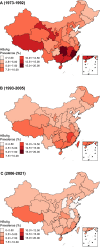Changing prevalence of chronic hepatitis B virus infection in China between 1973 and 2021: a systematic literature review and meta-analysis of 3740 studies and 231 million people
- PMID: 37798085
- PMCID: PMC10715530
- DOI: 10.1136/gutjnl-2023-330691
Changing prevalence of chronic hepatitis B virus infection in China between 1973 and 2021: a systematic literature review and meta-analysis of 3740 studies and 231 million people
Abstract
Objective: China concentrates a large part of the global burden of HBV infection, playing a pivotal role in achieving the WHO 2030 global hepatitis elimination target.
Methods: We searched for studies reporting HBV surface antigen (HBsAg) seroprevalence in five databases until January 2023. Eligible data were pooled using a generalised linear mixed model with random effects to obtain summary HBsAg seroprevalence. Linear regression was used to estimate annual percentage change (APC) and HBsAg prevalence in 2021.
Results:
3740 studies, including 231 million subjects, were meta-analysed. HBsAg seroprevalence for the general population decreased from 9.6% (95% CI 8.4 to 10.9%) in 1973-1984 to 3.0% (95% CI 2.1 to 3.9%) in 2021 (APC=-3.77; p<0.0001). Decreases were more pronounced in children <5 years (APC=-7.72; p<0.0001) and 5-18 years (-7.58; p<0.0001), than in people aged 19-59 years (-2.44; p<0.0001), whereas HBsAg seroprevalence increased in persons ≥60 years (2.84; p=0.0007). Significant decreases were observed in all six major Chinese regions, in both men (APC=-3.90; p<0.0001) and women (-1.82; p<0.0001) and in high-risk populations. An estimated 43.3 million (95% uncertainty interval 30.7-55.9) persons remained infected with HBV in China in 2021 (3.0%), with notable heterogeneity by region (<1.5% in North China to>6% in Taiwan and Hong Kong) and age (0.3%, 1.0%, 4.7% and 5.6% for <5 years, 5-18 years, 19-59 years and
Conclusions: China has experienced remarkable decreases in HBV infection over the last four decades, but variations in HBsAg prevalence persist in subpopulations. Ongoing prevention of HBV transmission is needed to meet HBV elimination targets by 2030.
Trial registration number: PROSPERO (CRD42021284217).
Keywords: HEPATITIS B; META-ANALYSIS.
© World Health Organization 2023. Licensee BMJ.
Conflict of interest statement
Competing interests: None declared.
Figures




Similar articles
-
Antenatal hepatitis B virus sero-prevalence, risk factors, pregnancy outcomes and vertical transmission rate within 24 months after birth in a high HIV prevalence setting.BMC Infect Dis. 2023 Oct 27;23(1):736. doi: 10.1186/s12879-023-08523-2. BMC Infect Dis. 2023. PMID: 37891471 Free PMC article.
-
Global epidemiology of hepatitis B virus infection: new estimates of age-specific HBsAg seroprevalence and endemicity.Vaccine. 2012 Mar 9;30(12):2212-9. doi: 10.1016/j.vaccine.2011.12.116. Epub 2012 Jan 24. Vaccine. 2012. PMID: 22273662
-
A meta-analysis of HBsAg-positive rate among general Chinese populations aged 1--59 years.Infect Dis (Lond). 2015;47(12):878-88. doi: 10.3109/23744235.2015.1064541. Epub 2015 Aug 24. Infect Dis (Lond). 2015. PMID: 26305713 Review.
-
Time trends of chronic HBV infection over prior decades - A global analysis.J Hepatol. 2017 Jan;66(1):48-54. doi: 10.1016/j.jhep.2016.08.013. Epub 2016 Aug 31. J Hepatol. 2017. PMID: 27592304
-
Correlates of chronic hepatitis B virus infection in the general adult population of China: Systematic review and meta-analysis.J Viral Hepat. 2023 Jun;30(6):470-488. doi: 10.1111/jvh.13816. Epub 2023 Feb 21. J Viral Hepat. 2023. PMID: 36751939 Review.
Cited by
-
Global, regional, and national total burden related to hepatitis B in children and adolescents from 1990 to 2021.BMC Public Health. 2024 Oct 23;24(1):2936. doi: 10.1186/s12889-024-20462-4. BMC Public Health. 2024. PMID: 39443929 Free PMC article.
-
Comparison between Liver Cancer Mortality Rates in China and Spain.J Clin Transl Hepatol. 2024 Oct 28;12(10):831-833. doi: 10.14218/JCTH.2024.00219. Epub 2024 Sep 13. J Clin Transl Hepatol. 2024. PMID: 39440219 Free PMC article. No abstract available.
-
Nomograms for predicting short-term mortality in acute-on-chronic liver disease caused by the combination of hepatitis B virus and alcohol.Sci Rep. 2024 Oct 19;14(1):24578. doi: 10.1038/s41598-024-76473-z. Sci Rep. 2024. PMID: 39427018 Free PMC article.
-
Associations between single nucleotide polymorphisms of cytokines and hepatitis B virus-related liver cirrhosis: A case-control study.Immun Inflamm Dis. 2024 Sep;12(9):e70017. doi: 10.1002/iid3.70017. Immun Inflamm Dis. 2024. PMID: 39315805 Free PMC article.
-
Results of mother-to-child transmission in hepatitis B-positive mothers who underwent amniocentesis.BMC Infect Dis. 2024 Sep 11;24(1):957. doi: 10.1186/s12879-024-09848-2. BMC Infect Dis. 2024. PMID: 39261777 Free PMC article.
References
Publication types
MeSH terms
Substances
Grants and funding
LinkOut - more resources
Full Text Sources
Medical
